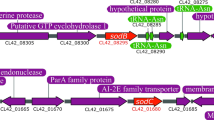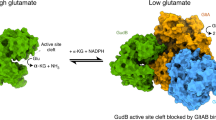Abstract
AMONG mutants obtained by heating dry spores of B. subtilis1 and detected by their loss of the ability to grow on glycerol–ammonium medium, one mutant (Marburg C4–4) behaves in an unexpected way. As with other mutants or other strains of the same species, growth occurs with the addition of glutamate2. The glutamate can be replaced by arginine, proline and ornithine, as would be expected from the occurrence in Bacilli of an inducible enzymatic decomposition of these amino-acids into glutamate2,3. However, in contrast to most cases, aspartate does not support growth in spite of an active asparto-glutamic transaminase. In addition, the oxidation of the dicarboxylic acids and the citric acid present in the parent strain (Marburg C4) vanishes strikingly in the mutant, in both cases after a growth in the same medium (glycerol, glutamate) (Table 1). Contrasting with the lack of oxidation by the resting cells, lysozyme lysates of concentrated suspensions of the mutant as well as parent oxidize the dicarboxylic acids and isocitric acid at the same speed. The only difference is the incapacity of the mutant lysate to oxidize citrate and cis-aconitate (Table 2). A specific test4 shows that both activities of aconitase (hydration and dehydration) are absent in the mutant; isocitric dehydrogenase remains present (Table 3).
This is a preview of subscription content, access via your institution
Access options
Subscribe to this journal
Receive 51 print issues and online access
$199.00 per year
only $3.90 per issue
Buy this article
- Purchase on Springer Link
- Instant access to full article PDF
Prices may be subject to local taxes which are calculated during checkout
Similar content being viewed by others
References
Zamenhof, S., Proc. U.S. Nat. Acad. Sci., 46, 101 (1960).
Wiame, J. M., and Storck, R., Biochim. Biophys. Acta, 10, 268 (1953).
Wiame, J. M., De Hauwer, G., and Messin, Simone, Arch. Int. Physiol. Biochim., 69, 104 (1961).
Racker, E., Biochim. Biophys. Acta, 4, 211 (1950).
Rickenberg, H. V., Cohen, G. N., Buttin, G., and Monod, J., Ann. Inst. Pasteur, 91, 829 (1956).
Davis, B. D., in Enzymes: Units of Biological Structure and Function, edit. by Gaebler, O. H. (Academic Press, New York, 1956).
Gilvarg, Ch., and Davis, B. D., J. Biol. Chem., 222, 307 (1956).
Shen San-Chiun, Hong Mong-Ming, and Braunstein, A. E., Biokhimija, 24, 957 (1959).
Jacob, F., and Monod, J., C.R. Acad. Sci., Paris, 249, 1282 (1959).
Author information
Authors and Affiliations
Rights and permissions
About this article
Cite this article
RAMOS, F., WIAME, J., WYNANTS, J. et al. Effect of Mutant of Bacillus subtilis on the Specific Transport of Aconitase and Dicarboxylic Acid. Nature 193, 70–71 (1962). https://doi.org/10.1038/193070a0
Issue Date:
DOI: https://doi.org/10.1038/193070a0
Comments
By submitting a comment you agree to abide by our Terms and Community Guidelines. If you find something abusive or that does not comply with our terms or guidelines please flag it as inappropriate.



